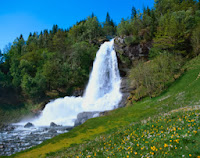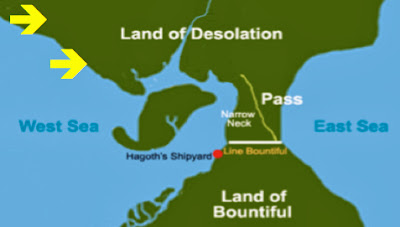Comment: “Amalickiah abandoning the attempt to get to the land northward, shows that the seashore would be by the sea leading to the land northward, which would be the Sea West. There is precedent for this seashore to be the Sea West shore. Morianton and his people came from the land of Morianton on the Sea East shore to the narrow pass on the Sea West shore that lead to the land northward. Amalickiah came from the city of Mulek on the Sea East shore with the intent to get to the land northward.”
The Isthmus of Tehuantepec, Sorenson's and Mesoamericanists Narrow Neck of Land in the Land of Promise, is 120 miles across as the crow flies, but 144 miles travel distance
Response: The problem with this thinking is when using Mesoamerica, the narrow area (Isthmus of Tehuantepec) is 144 miles across, thus the two shores are separated by a considerable distance. However, Mormon’s description indicates a Narrow Neck, which by definition, is Narrow! Thus, these two shores at the narrow neck of land would be very close, maybe 25 miles or so across (“a day-and-a-half journey”). Consequently, both Amalakiah and Morianton were along the East Sea, with intent to pass through the narrow neck of land into the Land Northward.
This is shown, in Amalakiah’s case, as he had been capturing cities all along the eastern shore (Alma 51:24-26), and in Morianton’s case as the city of Lehi and Morianton were bordered by the seashore (Alma 50:25; 51:26), which was along the East Sea.There is never any mention of the West Sea in either of these two events other than to tell us that the narrow pass through the narrow neck of land ran between the Sea East and the Sea West.
Since there is both a sea to the west (Alma 63:5) and a sea to the east (Ether 9:2) around the Land Northward, the statement in the article that “the sea leading to the land northward which would be the Sea West” is totally inaccurate.
Comment: “The Lamanites retreated away from the land Bountiful and retreated with all their army into the city of Mulek. The land northward is on the other side of the land Bountiful than the land of Mulek (Alma 52:2). There is a general line from the land northward to the land Bountiful to the city of Mulek.”
The city of Mulek was along the east seashore (Alma 51:26) within easy marching distance of the city of Bountiful in the Land of Bountiful (Alma 51:26,32)
Response: There is no indication that the city of Mulek was south of the land of Bountiful. In fact, it would appear that it was to the east, since it was along the seashore and we have no indication that the land of Bountiful stretched to the Sea East. Thus, there would be no general line between these three areas. The line would be from Mulek, westward through the Land of Bountiful to the narrow neck of land, then northward through the narrow neck to the Land of Desolation.
Comment: “The land Bountiful is in proximity to a narrow pass that led into the land northward. The land Bountiful is a strategic location to defend the narrow pass, possibly next to the narrow pass (Alma 52:9).”
Response: The land of Bountiful is to the south of the narrow neck of land, not next to it, but having a common boundary with the Land of Bountiful, and thus was in a strategic location to defend the narrow neck and the narrow pass than ran through the pass to the north of Bountiful (Alma 22:29-31).
Comment: “Alma 52:11 shows that the land by the west sea (Sea West) is not the land Bountiful. Moroni was defending against Lamanites coming from the south, so the land by the west sea would be southward of the land Bountiful.”
Teancum’s battles were along the eastern seashore near Bountiful while Moroni was putting down a Lamanite incursion along then western seashore
Response: The Land of Bountiful stretched to the West Sea (Alma 63:5). There is no mention in the scriptural record of a land to the west of Bountiful. On the other hand, the incident cited above is regarding the fact that the Lamanites had been harassing Moroni’s army on the west in the Land of Zarahemla and Moroni was engaged in a battle with them there and and was unable to join Teancum in his fight on that quarter of the land” in the east.
Comment: “The land Bountiful borders the land Desolation at a point in the narrow neck by the west sea. Alma 63:5 also implies that the land northward is far enough from the narrow neck to warrant going there by ship rather than over land. The phrase 'into the land northward' indicates that the land northward is outside the area defined as the narrow neck. That a ship is needed to get to the land northward indicates the land northward is not close to the narrow neck.”
Response: “the narrow neck which led into the land northward” (Alma 63:5). “Into” means “inside of” “to a point of contact with,” used to indicate “insertion” or “entry.” The fact that the narrow neck “led into” tells us that at the end of the narrow neck was the Land Northward. A ship was not needed to reach the Land Northward, which is shown by the statement: “in this year there were many people who went forth into the land northward.” (Alma 63:9) and “There were an exceedingly great many who departed out of the land of Zarahemla, and went forth unto the land northward to inherit the land.” (Helaman 3:3), both of these cases show that they went overland into the Land Northward. And those that went overland “And they did travel to an exceedingly great distance, insomuch that they came to large bodies of water and many rivers” (Helaman 3:4), showing that distance had nothing to do with the ship sailing, such as in the case of Corianton going with the ship that took supplies into the Land Northward (Alma 63:10). Thus, the statement only indicates that the area to which the ship went was not close to the narrow neck, not the overall Land Northward.
As for the Land Northward not being near the narrow neck, let’s not complicate simple language and descriptions. The narrow neck of land separated the Land of Bountiful from the Land of Desolation: “on the north, even until they came to the land which they called Bountiful. It bordered upon the land which they called Desolation” (Alma 22:29-30), “thus the land on the northward was called Desolation, and the land on the southward was called Bountiful” (Alma 22:31). As a result, Desolation was in the Land Northward, and Bountiful was in the Land Southward. These two lands, of course, were separated by a narrow neck of land (Alma 22:32; 63:5). Thus, the Land Northward boundary and the Land of Desolation boundary, being the same, began at the northern terminus of the narrow neck.
Short distance emigration by ship is seldom worthwhile when comparing the cost of building such ships as Mormon described:”exceedingly large”
As for the Hagoth’s ships traveling northward, any ship is only going to get close enough to any northern location that is along the coast—in this case, the West coast. To incur the cost of building an “exceeding large ship” to transport people to a place to which they could move overland is not feasible and would normally not be done. Almost all historical information on such matters shows that migration went overland where it could, and by ship only when the new land was disjoined from the old, or where extreme dangers existed in a direct route overland. To arbitrarily state that this land which was northward is the same as the land northward, when it is not called that, but easily could have been and is everywhere else in the scriptural record, should suggest that there was something different about the destination of these ships that went north.
Comment: “In Mormon 6:4 we find that the hill Cumorah was in “a land of many waters, rivers and fountains. Fountains are deep pools in rivers. The term 'many waters' means a sea. This puts the land of Cumorah in proximity to a sea. Since the land of dry bones is the same as the land of Cumorah and the bones came from the armies of Shiz and Coriantumr, the sea would be the Sea East.”
 Response: Let’s take a more
serious look at this idea of many waters, rivers and fountains. First of all,
the word “fountains” means a spring or source of water, the source or head of a
stream, the source or origin, genesis or wellspring (bountiful source of
water). It is a spring of water issuing from the earth, a fountainhead, or
wellhead—a place where a spring comes out of the ground. Second, “many waters”
can mean a very large sea, or an area where numerous waterways, lakes, lagoons, channels,
estuaries, pools, waterfalls, or waterway. It is not limited to being a sea.
Thus, the idea of many waters, rivers, and fountains would be a large tract of
land covered with water, sitting and running, from various sources, including
springs and other source water, in places mingling into rivers and other bodies
of water, such as falls, pools, lakes, etc. However, since Mormon includes the
word “fountains,” it should be considered that this land of many waters would
be up in the mountains, probably a mountain valley, where water sources begin
and flow.
Response: Let’s take a more
serious look at this idea of many waters, rivers and fountains. First of all,
the word “fountains” means a spring or source of water, the source or head of a
stream, the source or origin, genesis or wellspring (bountiful source of
water). It is a spring of water issuing from the earth, a fountainhead, or
wellhead—a place where a spring comes out of the ground. Second, “many waters”
can mean a very large sea, or an area where numerous waterways, lakes, lagoons, channels,
estuaries, pools, waterfalls, or waterway. It is not limited to being a sea.
Thus, the idea of many waters, rivers, and fountains would be a large tract of
land covered with water, sitting and running, from various sources, including
springs and other source water, in places mingling into rivers and other bodies
of water, such as falls, pools, lakes, etc. However, since Mormon includes the
word “fountains,” it should be considered that this land of many waters would
be up in the mountains, probably a mountain valley, where water sources begin
and flow.(See the next post, “The Land Northward – Part IV,” for more information from the Article and our responses to it)








No comments:
Post a Comment